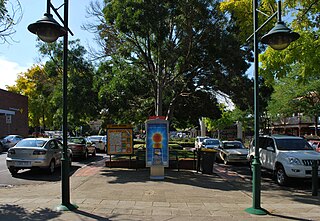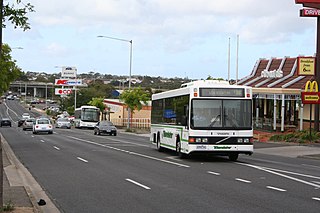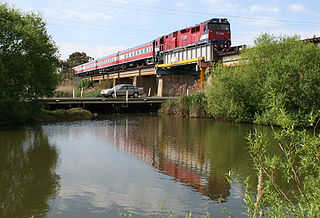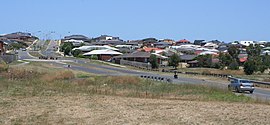
Geelong is a port city in Victoria, Australia, located at the eastern end of Corio Bay and the left bank of Barwon River, about 75 km (47 mi) southwest of Melbourne. With an estimated population of 282,809 in 2023, Geelong is the second largest city in the state of Victoria. It is the administrative centre for the City of Greater Geelong municipality, which is Port Phillip's only regional metropolitan area, and covers all the urban, rural and coastal reserves around the city including the entire Bellarine Peninsula and running from the plains of Lara in the north to the rolling hills of Waurn Ponds to the south, with Corio Bay to the east and the Barrabool Hills to the west.

Princes Highway is a major road in Australia, extending from Sydney via Melbourne to Adelaide through the states of New South Wales, Victoria and South Australia. It has a length of 1,941 kilometres (1,206 mi) or 1,898 kilometres (1,179 mi) via the former alignments of the highway, although these routes are slower and connections to the bypassed sections of the original route are poor in many cases.

Burwood is an inner eastern suburb of Melbourne, Victoria, Australia, 14 kilometres east of Melbourne's Central Business District, located within the Cities of Monash and Whitehorse local government areas. Burwood recorded a population of 15,147 at the 2021 census.

Princes Freeway is a 159-kilometre (99 mi) Australian freeway, divided into two sections, both located in Victoria, Australia. The freeway links Melbourne to Geelong in the west, and to Morwell in the east. It continues beyond these extremities as the Princes Highway towards Adelaide to the west and Sydney to the northeast. The freeway bears the designation M1.

Grovedale is a southern suburb of Geelong, Victoria, Australia. At the 2021 census, Grovedale had a population of 14,869.

Highton is a residential suburb of Geelong, Victoria, Australia. With views across Geelong, Corio Bay and the surrounding region, Highton is located along the banks of the Barwon River and across the rolling Barrabool Hills. The Barwon River straddles Highton to the north and east, while it is bordered by the hilly Ceres and Wandana Heights to the west, the former Kardinia Creek separates the suburb from Belmont to the south-east, and the Princes Highway and Pigdons Road to the south separate the suburb from Waurn Ponds.

Belmont is a southern suburb of Geelong, Victoria, Australia. The name means "beautiful hill". Belmont is geographically separated from the Geelong central business district by the Barwon River. The suburb is primarily residential, with some light industry along Barwon Heads Road. The suburb is part of the City of Greater Geelong local government area. At the 2011 census, Belmont had a population of 13,616.

Geelong railway station is a regional railway station on the Warrnambool line, which is part of the Regional railway network. It serves the city Geelong, in Victoria, Australia. Geelong station is a ground-level unstaffed station, featuring three platforms, an island platform with two faces and one side platform. It opened on 1 November 1856.

South Geelong railway station is a regional railway station on the Warrnambool line, which is part of the Regional railway network. It serves the southern Geelong suburb of South Geelong, in Victoria, Australia. South Geelong station is a ground level premium station, featuring two side platforms, connected by an accessible footbridge and concourse. It opened on 1 November 1883, with the current station provided in 2024.

North Geelong railway station is a regional railway station on the Warrnambool line, which is part of the Regional railway network. It serves the northern Geelong suburb of North Geelong, in Victoria, Australia. North Geelong station is a ground-level unstaffed station, featuring two side platforms. It opened on 1 August 1883, with the current station provided in 1990.

North Shore railway station is a regional railway station on the Warrnambool line, which is part of the Regional railway network. It serves the northern Geelong suburbs of North Shore and Norlane, in Victoria, Australia. North Shore station is a ground-level unstaffed station, featuring two side platforms. It opened on 15 April 1895, with the current station provided in 1991.

Lara railway station is located on the Warrnambool line in Victoria, Australia. It serves the town of Lara, and it opened on 1 November 1856 as Duck Ponds. It was renamed Lara on 30 June 1875.

The Warrnambool line is a long-distance regional rail service in Victoria, Australia. Operated by V/Line, it is the state's fourth longest railway line at 267.3 kilometres (166.1 mi). The line runs from Southern Cross station in central Melbourne to Warrnambool station in the south-west, serving 21 stations via Wyndham Vale, Geelong, Waurn Ponds, and Colac. The line has five return services each weekday and three return services on weekends. Trains on the Warrnambool service run with three- to five-car N-class carriage sets, which are hauled by N class locomotives.

Marshall railway station is a regional railway station on the Warrnambool line, which is part of the Regional railway network. It serves the southern Geelong suburb of Marshall, in Victoria, Australia. Marshall station is a ground level premium station, featuring two side platforms, connected by an accessible footbridge and concourse. It opened on 14 July 1879, with the current station provided in 2024. It initially closed on 14 October 1957, then reopened on 26 April 2005.

Waurn Ponds Shopping Centre is a major regional shopping centre servicing the southern suburbs of the city of Geelong, Victoria, Australia. It is located on the corner of Colac and Pioneer Roads in the suburb of Grovedale.

The Warrnambool railway line is a railway serving the south west of Victoria, Australia. Running from the western Melbourne suburb of Newport through the cities of Geelong and Warrnambool, the line once terminated at the coastal town of Port Fairy before being truncated to Dennington. This closed section of line has been converted into the 37 km long Port Fairy to Warrnambool Rail Trail. The line continues to see both passenger and freight services today.

Waurn Ponds railway station is located on the Warrnambool line in Victoria, Australia. It serves the southern Geelong suburb of the same name, and opened on 12 October 2014.
Surfcoast Highway is a semi-rural highway in Victoria, Australia, connecting the city of Geelong with the coastal town of Torquay. The highway runs through the Armstrong Creek Growth Area, which is the subject of extensive residential development; closer to Torquay, tourist attractions the Narana Creations indigenous centre, Surf Coast Plaza retail centre, and the Surfworld museum are located along the highway.
Freshwater Creek is a small rural community in the Surf Coast Shire, Victoria, Australia. In the 2016 census, Freshwater Creek had a population of 414 people.
Grovedale was a railway station on the outskirts of Geelong, located on the Warrnambool railway line in Victoria, Australia. Located near the current Torquay Road level crossing, the station opened in 1876 as Germantown and was renamed Grovedale in February 1916.






















